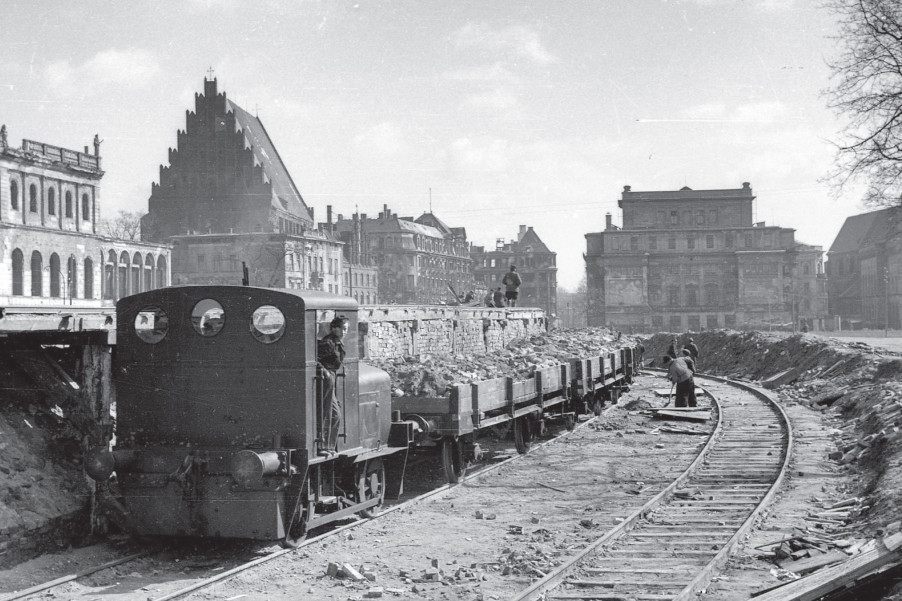In May 1945, Wrocław was still a burning pile of rubble. Of the 30,000 houses that stood before the siege of Festung Breslau, 21,600 turned into ruin.
And yet in this cemetery, on 29 June, a concert of an orchestra, which performed under the name of “Wrocław Philharmonic”, took place. The Soviet commander was so impressed by the artists’ performance that he sent one hundred litres of wine to the City Theatre (today the Opera House).
It was probably the first concert at the so-called Western Territories after the end of the war. It was organized on the occasion of the “Sea Day” to add splendour to the academy. There were only five Poles among the musicians, including the founder of the orchestra: Stefan Syryłło, violinist and conductor, before the war president of the Kraków Branch of the Musicians’ Union. The orchestra played in the Langhans building in Świdnicka Street, and the programme included works by Polish and Russian composers – Chopin’s Polonaise in A major, Stanisław Moniuszko’s Fairy Tale, Ignacy Paderewski’s Melody, Pyotr Tchaikovsky’s Capriccio Italiano and Xaver Scharvenka’s Mazurka.
Wrocław had heard many concerts, applauded the world’s most famous orchestras, great conductors and soloists. It had admired Paganini, Wieniawski and Brahms, reviewed Wagner and Liszt, and appreciated Chopin and Paderewski. But this concert on the occasion of “Sea Day” was something really extraordinary. In the city that did not exist, because it lay under 18 million cubic meters of rubble, music was heard. A bridge was thrown from the normal world that everyone in the destroyed fortress had forgotten.
Out of 104 university buildings, 70 were completely destroyed. None of the city’s main museums survived. Out of 658 km of streets, as much as 300 km were damaged during the bombings, the water supply system was damaged in three thousand places, and the sewage system – in seven thousand.
The act of surrender of Festung Breslau was signed on 6 May, and the next day the Soviets started blowing the city up in smoke. “We enter the city along Opolska and Kościuszki streets. Wrocław is on fire, the streets are covered with the rubble of burning houses. You can hear the crackling of the ammunition exploding from the fires ... After an hour-long journey through smoke and fire, we land next to the main Soviet headquarters of the city, which was located at Nankiera Square,” wrote engineer Kazimierz Kuligowski, the first Polish Deputy Mayor of Wrocław, in his memoirs.
Professor Edward Marczewski, a mathematician, kept for years a piece of paper he wrote in pencil on 10 May 1945: “University Library (Sand Insel). The building is partially burnt. Cellars transformed into shelters. I haven’t found the book collections. Several typewriters, duplicators, pencils etc. Chests of bread, canned food, biscuits. If these food supplies are to be taken for our authorities, it must be done quickly (it is being looted by German women). Marczewski”. On the back of the card there is a note: “The building is not very dilapidated, a fragment of books on the shelves, OST Europa Institut.” It quickly turned out to be out of date. On the night of 10 May, a fire broke out in the building of the Eastern Institute at Neue Sandstrasse (St Hedwig Str), from which the Church of St Anna went up in flames (today the Church of St Cyril, St Methodius and St Anna). This is where the 300,000 books collection of the German University Library was located. There was no chance of rescue.
“Water is out of the question. City waterworks destroyed. Too far to the Oder, no vessels anyway. The attempts to save are limited to removing the falling debris and throwing overboard books that have begun to smolder. At this point, there is a deafening roar. A cloud of black, hot and sparkling dust flows through the shattered vault of the church and the broken gate. We are enveloped in darkness,” recalled Professor Stanisław Kulczyński, the first Polish Rector of the University.
Life in the ruins was more than dangerous, the looters tried to burgle the cadaver of a city, Polish, Soviet and German gangs passed through Wrocław, robbing everything they could. Yet life sprouted from the rubble.
The first electricity was supplied on 12 May to the seat of the City Board at 25-27 Poniatowskiego Str. The first post office was opened on 16 May at 47 Jedności Narodowej Str (then still Matthiasstrasse). The first Wrocław newspaper, Nasz Wrocław, came out on 10 June in the amount of 3,000 copies, and it was printed by the Municipal Printing House at Piotra Skargi Street. The first Polish reading room and library was opened on 20 June at 17 Jedności Narodowej Str. The first bus line was launched on 2June. The bus ran twice a day and transported officials of the City Board from Karłowice to Podwale. For the first two weeks, passengers paid nothing, then they bought a ticket for one zloty.
And finally it was time for the first concert. On 29 June 1945, the Wrocław Philharmonic began writing its history.
Beata Maciejewska

